
Louisiana, United States – Down in Cameron Parish, a storm-wracked region low on the coast of the Gulf of Mexico, Patrick Hebert has a talent for finding the dead.
Since 2005, he has found hundreds of lost caskets – stuck on levees and fences, tangled in brush or half-buried in marsh mud.
He pulls them out of shallow lakes, drags them off dikes, and tows them to dry land along shipping channels.
It happens every time a hurricane hits this corner of southwestern Louisiana: The force of the storm surge – a wall of water up to 5 metres (17 feet) high, racing inland – rips the doors off mausoleums, tears vaults out of the soft ground, and floats caskets away, into the marsh. Sometimes, Hebert says, they travel for miles.
Hebert, a marshland contractor, sits in his office, clicking around the satellite view of Cameron Parish marshes using Google Earth. He reads the territory with an expert eye, pointing out low piles of earth that can become debris backstops and casket collection points. And then he zooms way in, pointing to a tiny hump of mud in the marsh that bears a small, grey rectangle: a metal casket, ripped from its grave by a hurricane. Hebert picked up the casket around January 2023, but it is still visible on these satellite images from 2022.
“This lady right here,” Hebert, 48, says, eyes on the screen, “her son was real distraught”. The woman in the casket had been buried in Grand Chenier, a tiny coastal town where her son, Mike, still lives. She had been washed from her grave during Hurricane Laura in August 2020. “He called me several times – ‘You haven’t found her yet? You haven’t found her yet?’ So, we had been looking for this one.”
Hebert makes some quick calculations. “She went 3 miles [4.8km],” he says. “The water was high, maybe 10 feet [3 metres], so she just –” with a flat palm, he makes a floating gesture, then zips his hand off into the distance.
A couple of duck hunters had spotted the casket in the wetlands and given him a call to pick it up. Hebert and his helpers had taken an airboat out to the GPS coordinates the hunters sent and found it, flipped upside-down, on a tiny island of marsh grass peeking out of the brackish water: a faded blue-green casket capped by rust. It was heavy. The seal had broken, letting water in. They drilled holes in the casket, drained and lifted it; a messy job requiring brute strength. Finally, they got it in the boat, strapped it down, and headed back to more solid ground. A typical pickup; the kind they’ve now done hundreds of times.
But the problem of displaced caskets isn’t confined to Cameron Parish.
Since Hebert began picking up lost caskets almost two decades ago, the issue has only gotten worse. As the shoreline creeps closer, and hurricanes grow stronger, coastal communities across southern Louisiana are increasingly running into the same problem: The dead won’t stay put.
And as the seas rise, what is now a local issue will be increasingly faced by coastal communities across the world.

‘I knew about half of them’
Collecting the lost dead isn’t Hebert’s job. Nobody pays him. But he does it, he says, because if he doesn’t – who will?
He’s the only one around Cameron Parish equipped to do the work. That’s thanks to his fleet of airboats and marsh buggies – enormous amphibious vehicles that can both drive across wetlands and float on water, vehicles he normally uses to build levees throughout the parish, clear trails, and perform oil and gas pipeline repair work. There, in Louisiana’s largest and most sparsely populated parish, black-eyed alligators sun themselves along the roadside, and wildlife refuges teem with white egrets and snapping turtles. The parish’s towns sit on a ridge of highland along the Louisiana coast, the Gulf of Mexico laid out on one side, marsh on the other.
Hebert also takes on the task because this is his home. His own ancestors, dating back 180 years, are buried in the cemeteries here. The people he pulls from the marsh were friends, neighbours and family.
“I was related to a lot of those people,” says Hebert, a sturdy man with a neatly trimmed reddish beard and reading glasses tucked into his shirt collar. “I knew about half of them,” he estimates. He’s stepped outside his office and now leans on the hull of a red airboat at his headquarters in Bell City, a community of about 900 people north of Cameron Parish, on an overcast afternoon in March. “The other half, I’d know their family.”
If he didn’t do it, he says, he isn’t sure what would happen. He supposes they’d just be left to sit, decomposing in the marsh. Who, after all, is around to notice, to fight to rebury the dead? Few people, he says wryly, want to take care of his “little town” of Cameron – his hometown and namesake of the parish it sits in. “But I do.”
Hebert says he has periodically reached out for assistance to Louisiana’s statewide Cemetery Response Task Force, which helps families, contractors, and other applicants apply for funds from the Federal Emergency Management Agency (FEMA) and directs resources after a disaster in order to collect, identify, and reinter burials. He says he was repeatedly told the office was overwhelmed and understaffed. Once, when he applied through the Parish government to have some of his expenses reimbursed after Laura, it took more than a year to receive payment. A parish spokesperson told Al Jazeera they sent Hebert’s invoice to FEMA for reimbursement, but are still awaiting a decision and paid Hebert with the parish’s general funds in the meantime. Hebert is now a licensed contractor with the Governor’s Office of Homeland Security and Emergency Preparedness (GOHSEP), and so is paid for some of the work, like moving the caskets he has collected into trailers with a forklift so they can be brought to Baton Rouge, the Louisiana capital, for identification. The rest of the time, though, Hebert covers the costs himself – fuel, boat captain wages – to the tune of tens of thousands of dollars.
Amber Hargroder, Communications Officer at the Louisiana Department of Justice, which provides the staff for the Task Force’s daily operations, acknowledged that the problem of disrupted cemeteries is often overlooked. But in response to questions about the work Hebert has taken on at his own expense, she said that since he is not a Task Force contractor and therefore doesn’t “follow proper procedure”, he is “putting the deceased at risk of harm, looting, and damage” and adds that his actions are “reckless and unwarranted”. She gave no indication, however, that other contractors have been brought on to do this work in Hebert’s stead.
Once Hebert learned a Task Force had been formed, he called its chairman, Assistant Attorney General Ryan Seidmann, to keep him “in the loop” about his casket finds. He says that Seidmann gave him some instructions – for example, Hebert should write GPS coordinates on the casket lid, showing where it was found – but was never asked to become an official contractor. He never pursued it: It didn’t even occur to him, largely because he’d been doing the work on his own for so long – over a decade before the Task Force was launched. He also finds the state’s slow pace frustrating.
When he has gone through official channels, it has taken weeks for approval from the Task Force to retrieve even a single casket. And casket retrieval after autumn storms must be done quickly: Once spring arrives the scattered caskets will be swallowed up by a riot of green vegetation, making them virtually impossible to spot.
While Hebert takes on the trouble of collecting the dead himself, it is the Task Force that must use 18-wheeler trucks to bring the caskets to Baton Rouge. And that typically means a long wait. At the back of his workshed, Mike’s mother is still waiting.
To demonstrate, Hebert walks through the garage’s buzz of power tools, past his crew busily doing maintenance on the vehicles, brandishing metre-long wrenches. He continues on, to the back of his storage area. And there, tucked behind a twin-engine fishing boat, sit two caskets.
One is empty, dug out of a drainage canal with its bottom rusted out. The remains, lost somewhere in the marsh, will never be recovered.
He gently places his hand on the lid of the other. This casket, resting on pieces of lumber and surrounded by old pallets and worn hoses, holds Mike’s mother, waiting, almost three years after she washed away, to be reburied.
Once Hebert brought her casket back to his shop last winter, he’d had to do one last grim piece of work. Mike had wanted him to double-check that it was really his mother.
So Hebert opened the lid. Inside was a short, stout woman. He snapped a photo of the dress print. He texted it to Mike.
Yes. It was her.
Couldn’t leave them there
It wasn’t always this way.
The first time Hebert recovered caskets was in 2005, after Hurricane Rita. While driving around the marshes scattered with debris, Hebert and his crew kept coming across caskets. They agreed they couldn’t just leave them sitting there.
Back then, Hebert happened to have a guy named Joe driving airboats for him, a trained mortician who grew up in the funeral business. For Joe, it was only natural that they collect the caskets. His nonchalance, says Hebert, made the grim task easier to accept.
Since those first days, there has been much to accept. Once, Hebert recalls, after Rita, wading through a flooded cemetery to check on where his brother is buried, he accidentally plunged into an open underwater grave that’d been emptied by storm surge, its casket ripped out of the ground and lost. The waters went over his head, he remembers.
But after that first time, hurricanes kept hitting, destroying homes and cemeteries again and again. The storms are getting more frequent and severe – with more powerful winds, more rain, higher storm surge and more likelihood of hitting back-to-back, as Laura and Delta did in 2020 – due to climate change and warming seas.
And the waters keep rising, inch by inch.
Greenhouse gas emissions are causing the climate to warm to levels not seen in human history. Summer 2023 has been obliterating heat records so completely that even climate scientists are expressing baffled alarm: the hottest month and hottest ocean water in recorded human history; record-high sea surface temperatures and record-low levels of sea ice and a North Atlantic so hot it has blasted past even the most pessimistic climate model predictions. About 90 percent of global heating is absorbed by the world’s oceans. This heat causes sea waters to warm and expand, and sea ice and glaciers to melt, all of which cause sea level rise. Greenhouse gas emissions are still increasing. If they remain high, the world could see more than 1.8 metres (6 feet) of sea level rise by 2100.
Louisiana’s coast is also sinking and eroding, which all together means it is experiencing some of the most rapid land loss on earth: An American football field’s worth of land disappears into open water roughly every 48 minutes. Sea levels here have already risen about 0.6 metres (2 feet) since 1950.
Cameron, in particular, is disappearing at a staggering rate, the coastline retreating up to 9 metres (30 feet) per year. By the end of the century, some say, Cameron could be gone.

People are moving north
Back in his office, Hebert takes down a framed photo. In the picture, he and Joe drive an airboat, a casket strapped across the bow.
After Rita and Ike in 2008, Hebert got some degree of outside help. The Cameron Parish Sheriff sent over imprisoned men, let out of prison temporarily for work detail, to assist. The first several men seemed willing – until they had to open up one of the waterlogged, damaged caskets to put the remains in a protective body bag. “Then they were like, ‘Nah-ah, send me back to jail,’” Hebert recalls, wincing a little as he laughs.
Eventually, he found one good working partner, he says, a heavily tattooed man whom he still speaks of with warmth. But since Hurricane Ike, it’s been just Hebert and whichever of his handful of employees are up for it.
By now, he says, they’ve got this “down to a science”. For the first six weeks after a storm, they’ll scour the areas where they know caskets wash up, finding two or three every day. Most of the time, the seals are intact, so the caskets float. Sometimes, for the waterlogged ones, they have to cut the lid open and take out the body “or whatever’s left”. Sometimes they have to break open a cement vault with a sledgehammer. He estimates that they’ve found about 1,000 caskets in the past 18 years and that that number represents about 70 percent of what’s been displaced.
Hurricane Laura, he says, was “the worst one”. By then Hebert had already moved his office inland to Bell City because it had gotten destroyed by storms, twice. Besides, his homeowner’s insurance had quadrupled. Laura still ripped half the new place’s roof off.
Laura’s eye came in right about where Ebenezer Baptist Church once stood, near Creole, 24km (15 miles) east of Cameron. The storm was so powerful it derailed train cars, ripped houses from their foundations, and briefly reversed the flow of the Mississippi River. There is no church in Creole, anymore: Just a square of cement is left, bordered by sawgrass and dotted with a few displaced tombs torn from the cemetery next to it, where dozens of open graves filled with water reflect a steel-grey daytime sky.
A few months after the storm passed, an employee found Hebert’s great-uncle. They’d been looking for a while. Herbert recognised the brown casket, with Jesus’ disciples on each corner. But his cousins wanted to open the casket to identify him for sure.
Hebert “told them it’s a bad idea,” he recalls. The man, Hebert’s grandfather’s brother, had been dead for almost five years. He would be partially decomposed. But the cousins insisted.
When Hebert got it open, they couldn’t identify him by his face. But they recognised the brown three-piece suit.
When asked how it feels to pull people he knew out of the mud, Hebert brushes it off. “I mean, I’d rather be doing something else,” he acknowledges. “But it’s important. So, kind of – get it done, you know?”
Mainly, he’s disappointed that not a lot of people – including families of the displaced dead – have gotten involved with the recovery work. He believes that if the federal and state governments had shown meaningful interest in addressing the issue, he would not be left with an impossible choice when he comes across lost caskets: Ignore the dead, or pick them up himself, and store them back in Bell City.
For months after Laura, Hebert says, they had about 150 caskets stacked behind the office garage, until the Cemetery Response Task Force finally leased some semitrailers to collect them.
Hebert then sits back in his chair and starts to talk about the other missing – the living who’ve left Cameron, fleeing storms and land loss. The energy in his voice fades, and he suddenly sounds exhausted.
“Cameron has really just about gone away,” he says in a low tone. “The little towns right on the coast – we’ve seen such a huge migration of people moving north to get away from those hurricanes. So, I mean,” he sighs, “There’s not many people left living down there.”
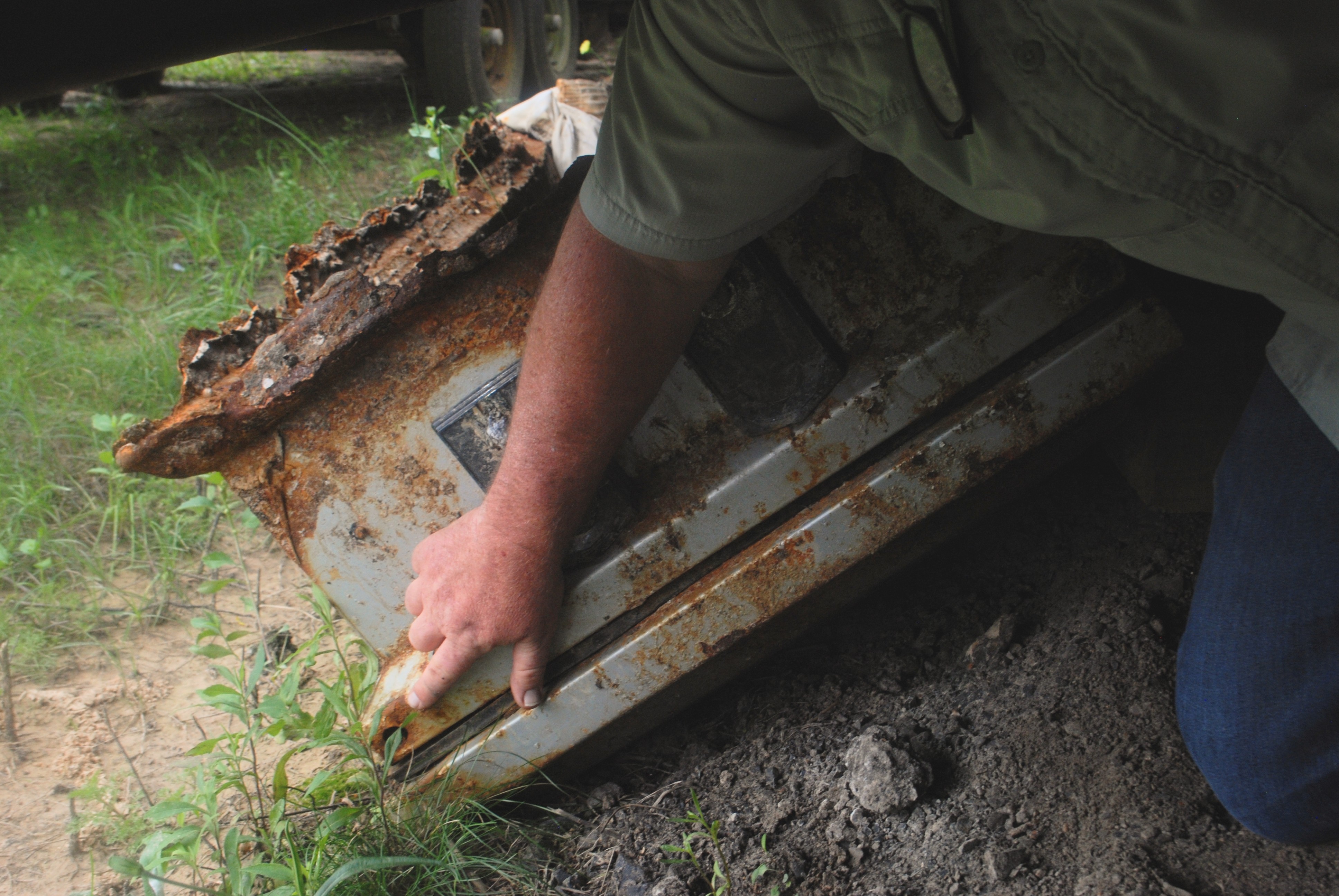
‘Just nothing left’
Dotted across Cameron Parish are the landing sites of tremendous, devastating storms, which once hit occasionally and now seem to come faster and faster: 1957’s Hurricane Audrey, 2005’s Hurricane Rita, then 2008’s Hurricane Ike and 2020’s Hurricane Laura, and then, less than two months later, Hurricane Delta, a succession of blows so unrelenting that, as Hebert’s wife Kayla puts it, the parish “got wiped out”.
You wouldn’t know the scope of the change if you weren’t looking for it. There are no piles of debris, and only a few wrecked houses standing. It would be easy to drive through these towns and imagine there was little to begin with. But that isn’t true: About 2,500 people used to live in Cameron when Hebert was a kid. He guesses there are maybe 50 people left.
All along the coast road, swallowed by long, slender marsh grasses, sit concrete slabs where buildings and homes used to be. There are no longer any banks in Cameron Parish, nor doctors’ offices, nor bars. There is no pharmacy, no bakery, no daycare. What’s left is a handful of RV parks, for the people who remain, mostly employees of the LNG export terminal down the road.
Sometimes, Hebert drives down to Cameron with Kayla, who grew up in Baton Rouge. He will point out the truck window at the town’s ghosts: Over there used to be an auto parts supply store, he’ll tell her; over there, a doughnut shop. Looking around at the overgrown lots, the cement stairs that lead to the sky, she struggles to believe it. “There’s just nothing left,” explains Hebert.
But generations of dead do remain in Cameron, and year after year, they are getting swept away.
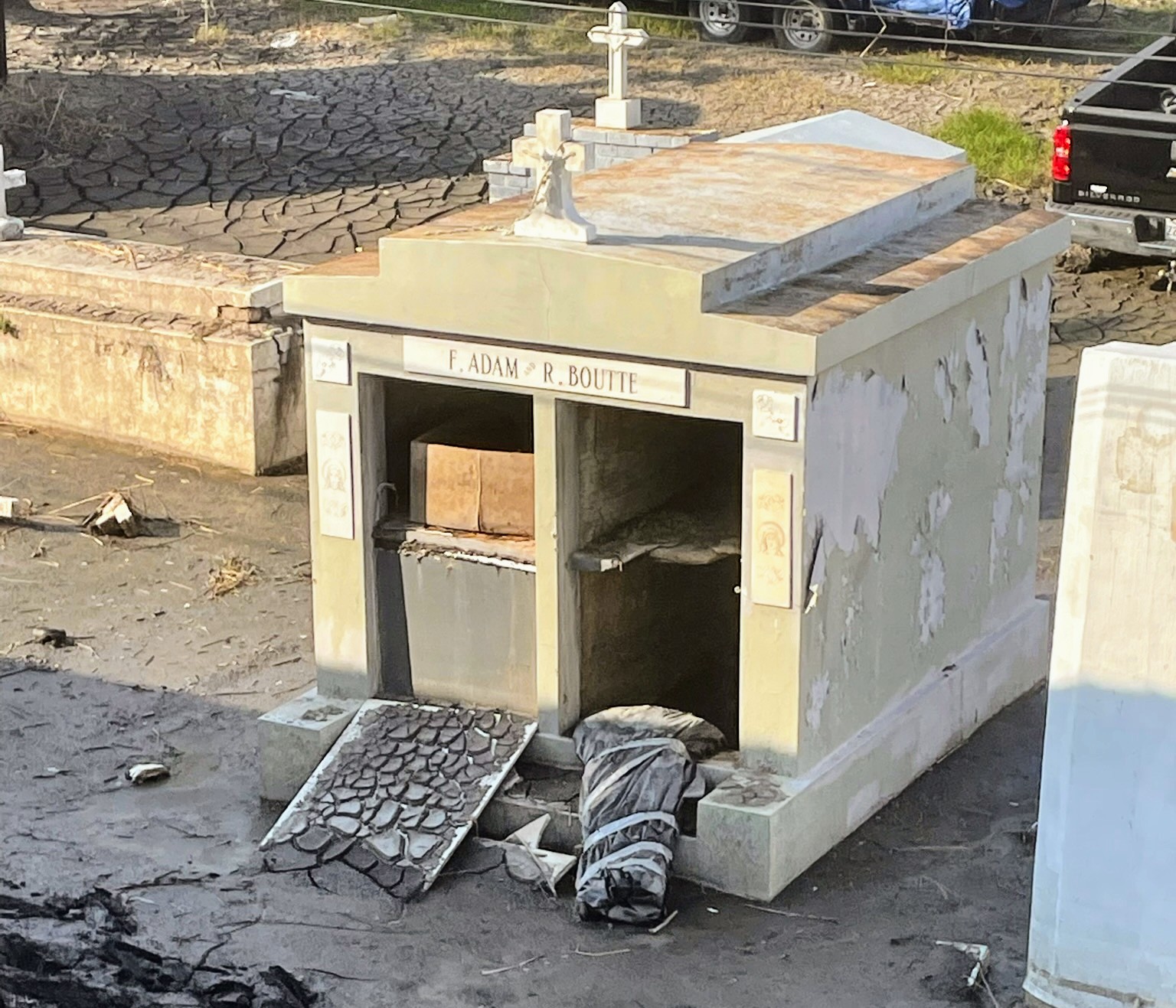
‘It ain’t getting no better’
It seems that everyone on the Louisiana coast has a recent story of the dead washing away.
In the town of Jean Lafitte, 290km (180 miles) east of Cameron, Mike Roberts, a fisherman in his 50s, recalls “hundreds” of caskets strewn around town after Hurricane Ida in 2021. “It was horrible. Everybody that lived in town found them. In the roads. In the bayou. Just everywhere.” Others recall caskets in backyards, caskets in the driveway blocking the route to work.
Down the road in the community of Lafitte, at a restaurant on an anchored barge, Kristen Tauzin, 42, takes a break from frying shrimp and recalls that when the waters receded, she looked out her window at home and saw “a body hanging out of the cement vault, taped up in a plastic bag”.
Tauzin’s home sits smack in between the barge restaurant and the small Coulon Cemetery. The vault had stayed put, but the raging waters of the storm – “the worst we ever had it” – tore the door off. Tauzin told anyone who’d listen, she says, looking for help, but every resource agency was overwhelmed, too busy with the living.
The body hung there for weeks, a month, two months. Finally, her boss put gloves on and pushed it back into the vault.
“It’s just gonna keep happening,” she concludes with a grim half-smile. “It ain’t getting no better.”
“No,” her colleague Gigi Phillips, 55, agrees. “It’s getting worse since the land is getting ate up so bad.”
Phillips isn’t missing any buried loved ones, but she is missing her two-bedroom house. During Ida it washed clear off the property, along with the home’s deed. Without documentation, she gave up on trying to get assistance for temporary housing from FEMA. Like others in the Lafitte region, she said that past attempts to access FEMA aid were so frustrating that she no longer bothers applying. She lives in a camper now. Easier to evacuate that way, Phillips says, next time a storm comes.
Across the canal, in the tiny community of Barataria, Penny Simon, 61, a retired school board clerk, can’t find her uncle, Merlin. “He floated away,” she says, seated on the couch while bottle-feeding her seven-week-old granddaughter Lucy. Merlin was a good guy, she says, silly but sweet, a lifelong shrimper born in this very house, which sits steps from the bayou atop 3.7-metre (12-foot) concrete pillars. The family cemetery is next door, some vaults still empty or shifted out of place.
“It’s happening more,” she adds, adjusting Lucy in her arms. “It’s the first time they floated away from this cemetery.” She worries about where he is every time she passes the graveyard. “They’re not at peace. You want them at peace,” she says. “They’ve been through enough.”
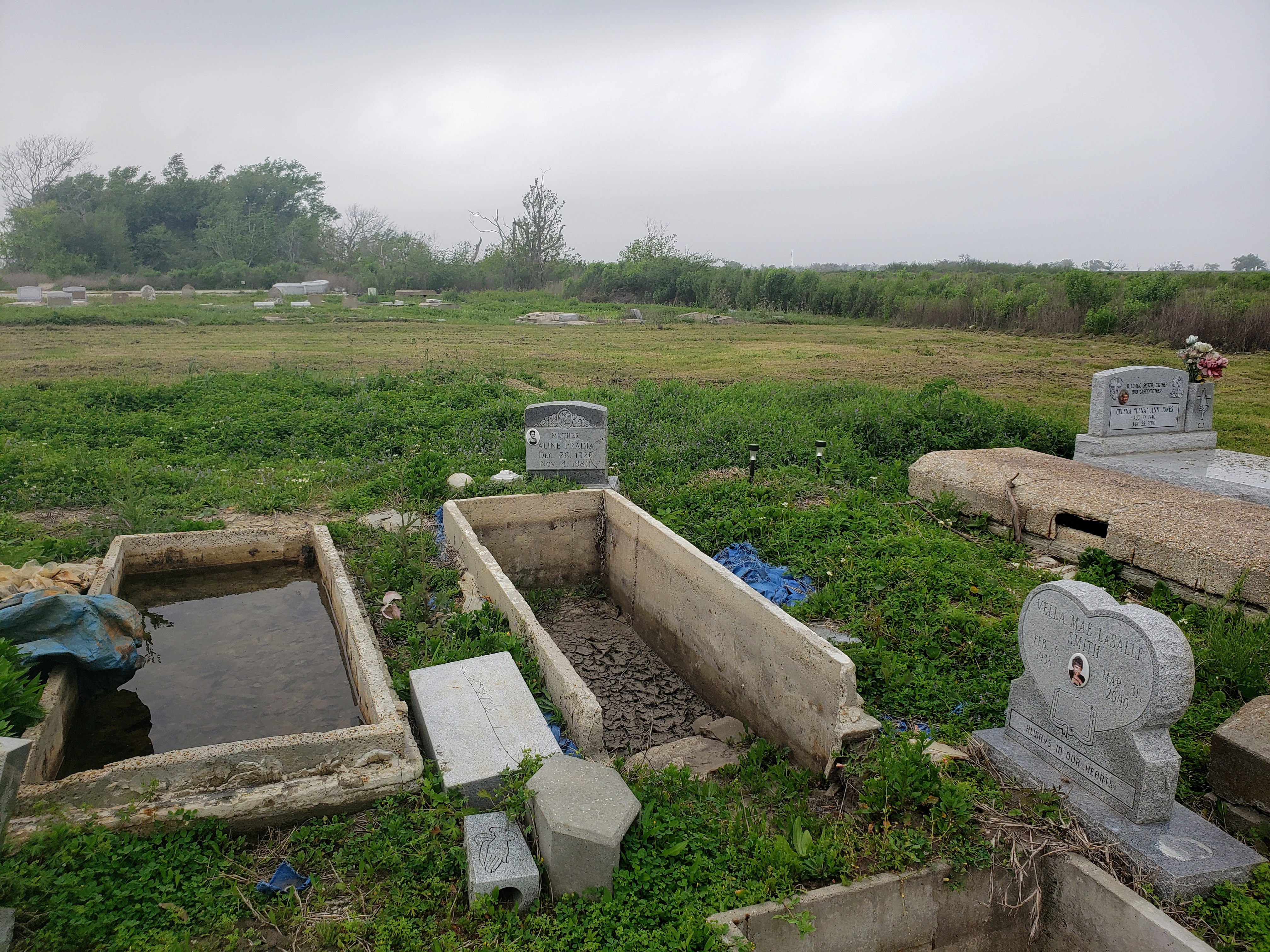
Records of the past
There are about 500 cemeteries in Louisiana’s coastal zone, says Jessica Schexnayder, coauthor of the 2017 book Fragile Grounds: Louisiana’s Endangered Cemeteries. As a forensic anthropologist working in coastal resilience, she’s seen a lot of them.
She and fellow forensic anthropologist Mary Manhein, nicknamed “The Bone Lady” for her expertise in identifying human remains, visited 138 coastal cemeteries to write the book, taking thousands of photos and walking their perimeters with a GPS to map their borders before the land is fully submerged.
It was clear, Schexnayder says, that cemeteries are being lost across coastal Louisiana. The project, she explains, “was really a race against time, to map what we could before it was gone”.
They did this mapping, she says, because graveyards are essential parts of a region’s cultural fabric. They also serve as a map of time.
“I noticed when we started mapping the cemeteries, you can see the immigration patterns of the state,” Schexnayder says. Their work revealed the movements of various groups who’d immigrated to – and shaped – Louisiana: Islenos from the Canary Islands, Acadians from Nova Scotia, Jewish immigrants from Germany and more. As populations move, and then are forced to move again, cemeteries are sometimes all that’s left behind as material proof of their presence.
Some cemeteries are already lost. At Point Pleasant Cemetery in Plaquemines Parish, you could mow the grass in the 1990s; now it’s underwater every high tide. The Isle de Jean Charles Band of the Biloxi-Chitimacha-Choctaw, an Indigenous community forced to relocate as 98 percent of their island’s land has been lost, have had to leave their cemetery behind. In Leeville, Lefort Cemetery has now slipped completely below the waters of Bayou Lafourche.
Seidmann of the Cemetery Response Task Force describes the issue as “fairly massive”. When the Task Force formed in 2018, it was responding to Hurricane Isaac, which had disrupted just under 100 burials. In 2016, flooding in central Louisiana disrupted more than 800. The final repair from that damage, he notes, was completed in March of this year. By hurricanes Laura and Delta in 2020, storms that “blasted a path all the way up to the Arkansas border”, they were looking at more than 3,000 damaged graves; Ida, the next year, washed so many caskets into the bayous around Lafitte that they struggled to pinpoint who had come from which cemetery. The Louisiana Department of Justice estimates the Task Force has repaired nearly 4,000 graves to date.
Seidmann says that repairing storm-doomed cemeteries is a Sisyphean task, nearly impossible to keep up with.
“I don’t know if it’s getting worse,” he says. “But I’d be lying if I didn’t tell you it’s been bad-bad.”
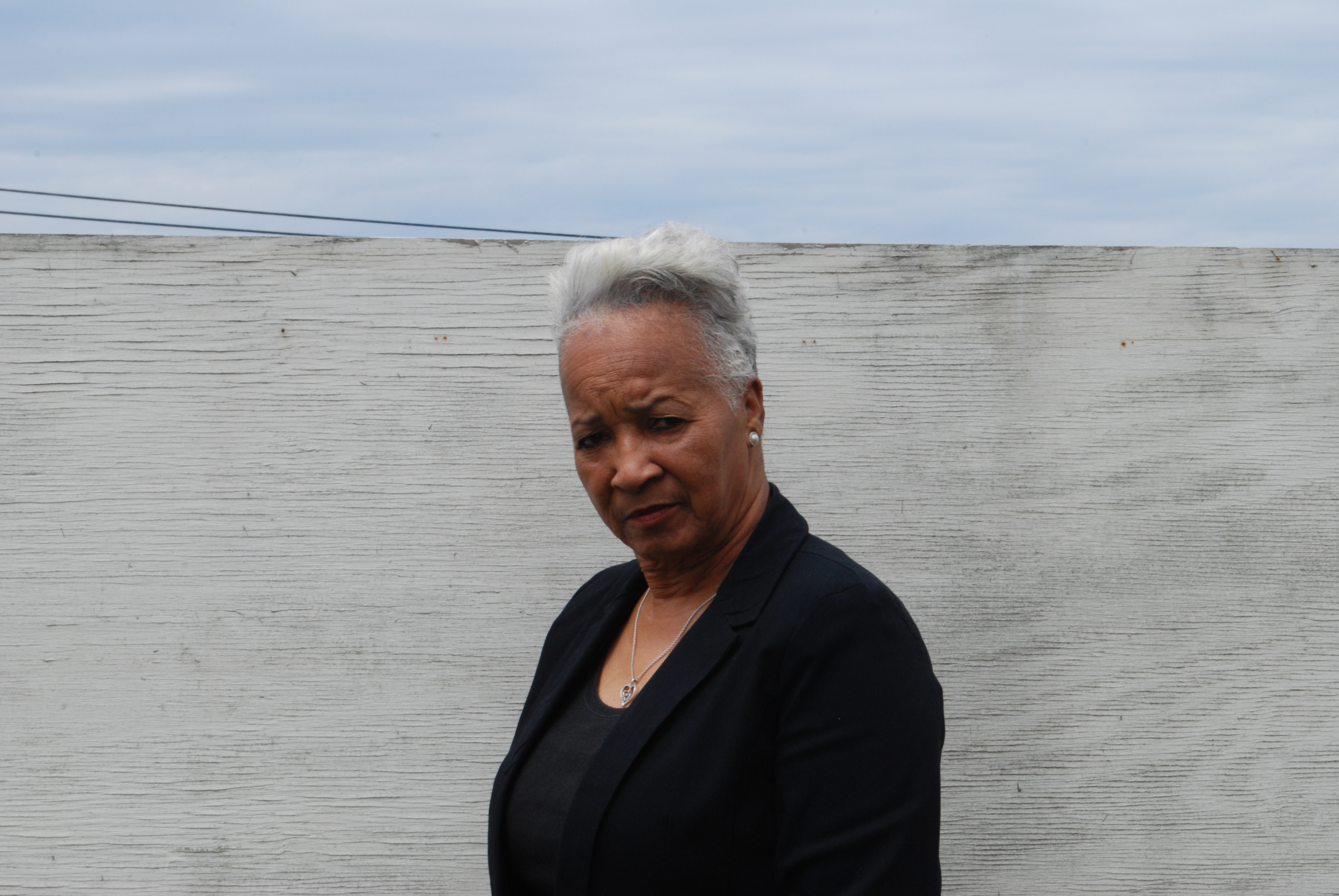
‘It’s always a fight’
As strengthening storms disrupt cemeteries, towns without a Patrick Hebert are forced to rely on local, state, and national agencies to recover the bodies. This has left historically neglected communities, like Audrey Trufant Salvant’s hometown of Ironton and its 100-odd residents, largely on their own.
When Ida charged through in August 2021, it shredded Louisiana’s power grid, broke rainfall records, and tied for the strongest winds to ever hit the state. Ironton was not spared.
“Where do I begin,” says Salvant, after a long pause. Poised, silver-haired, and dressed in a sharp black suit, the 69-year-old is a leader in this tiny community.
A retired Plaquemines Parish councilmember and civil rights activist, Salvant speaks sitting straight-backed in a plastic chair in a community centre in the parish seat of Belle Chasse, about 26km (16 miles) inland from Ironton. She’s here to meet with other Ironton residents and a FEMA liaison about Ida recovery efforts. Nearly two years after the hurricane, they’re still trying to put their hometown back together. On each of Ironton’s three blocks, residents are living in RVs in the shadow of their wrecked homes.
Salvant continues, carefully: “We’re accustomed to the neglect of the local government.”
Ironton was established by formerly enslaved people in the 1800s, and the town has since survived under near-impossible circumstances. Nestled against the Mississippi River about 32km (20 miles) south of New Orleans, Ironton sits in a parish which was, for much of the 20th century, led by a notorious segregationist who enforced racial separation. Ironton, then, as a historically Black town, has had to fight parish leadership for every piece of infrastructure it ever got.
Salvant’s mother, Mary Trufant, was instrumental in the effort to bring functional infrastructure to Ironton. Salvant, at first a bored child dragged along to organising meetings, eventually took up the mantle as she grew up and joined the struggle. It was 1980 when they finally got Ironton running water. Getting a sewage system and street lights, Salvant notes, took even longer.
“Nothing is given to Black people,” she emphasises. “It’s always a fight.”
Still, Salvant calls Ironton the “best place in the world” to grow up. Before Ida, about 200 people lived there. Salvant is a fifth-generation Ironton resident, “and I say that proudly,” she adds. Her hometown is peaceful, she says; quiet. There’s no crime. And nobody needs to lock their door since everybody knows one another.
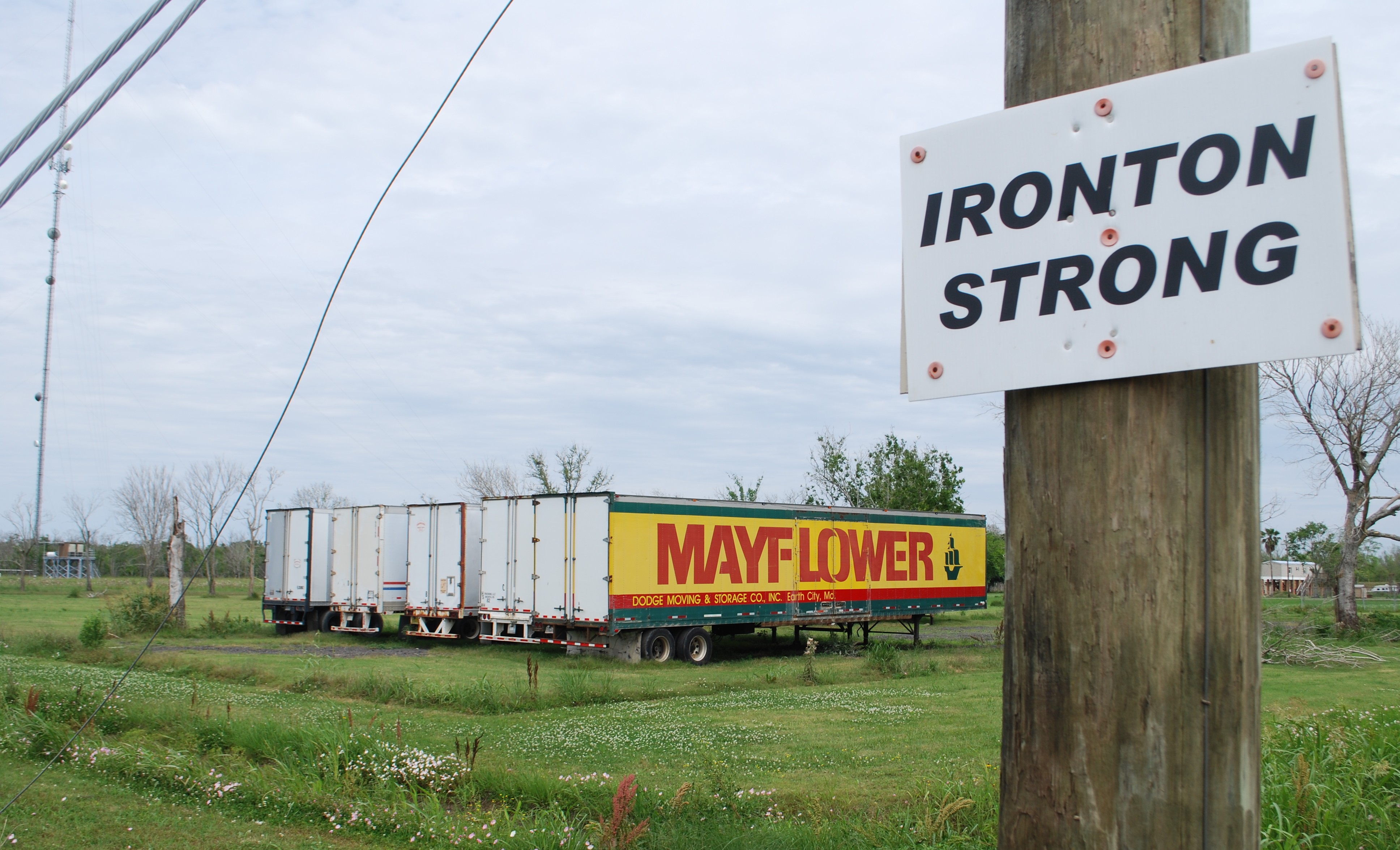
Trailers hold the dead
Salvant’s great-great-grandfather is buried in Ironton, as is her great-aunt, and her mother. She comes from a matrilineal line of advocates for Ironton; tough women from whom she says she inherited her leadership ability and tenacity. It’s also why the family cemetery is so important to her.
To own property as a Black person in Plaquemines Parish, Salvant says, was historically almost impossible. “And so for my family to be able to own property and erect their own cemetery … that’s a great accomplishment.” She remembers her great-aunt going to the family cemetery with flowers on Good Friday, celebrating her ancestors: “It was like a jubilee.”
When Hurricane Ida hit, it devastated Ironton, destroying nearly every home and both cemeteries. Caskets and vaults were strewn throughout the community. For months, while Ironton residents were still displaced, caskets sat end-up in the street, caked in mud or laid in ditches. Salvant feels that since most of her displaced neighbours had not yet been able to return, the parish and state government didn’t assign urgency to the removal of Ironton’s dead.
“You had some [caskets] that were obliterated, where the impact of the floodwater just blew them up, so you had potential remains throughout the community,” she recalls.
After her March midday meeting, to get back to Ironton, she’ll travel south along the winding bends of the river. She’ll pass through the massive gates of the concrete levee walls, beyond which, communities like hers are extremely vulnerable to storms, past oil refineries and signs advertising live shrimp for sale. And then she’ll take a left onto Ironton Road, passing six semitrailers parked in a field, within which are stacked Ironton’s dead, still waiting, 18 months after the storm, to be reinterred.
Salvant is incensed. Though all her family members have been reinterred in the family cemetery, she questions why the Cemetery Response Task Force has parked the trailers full of dead, “for months and months”, next to the only road that enters town.
“Every time someone leaves out of this community, they have to imagine their mother…” she trails off, tightening her jaw.
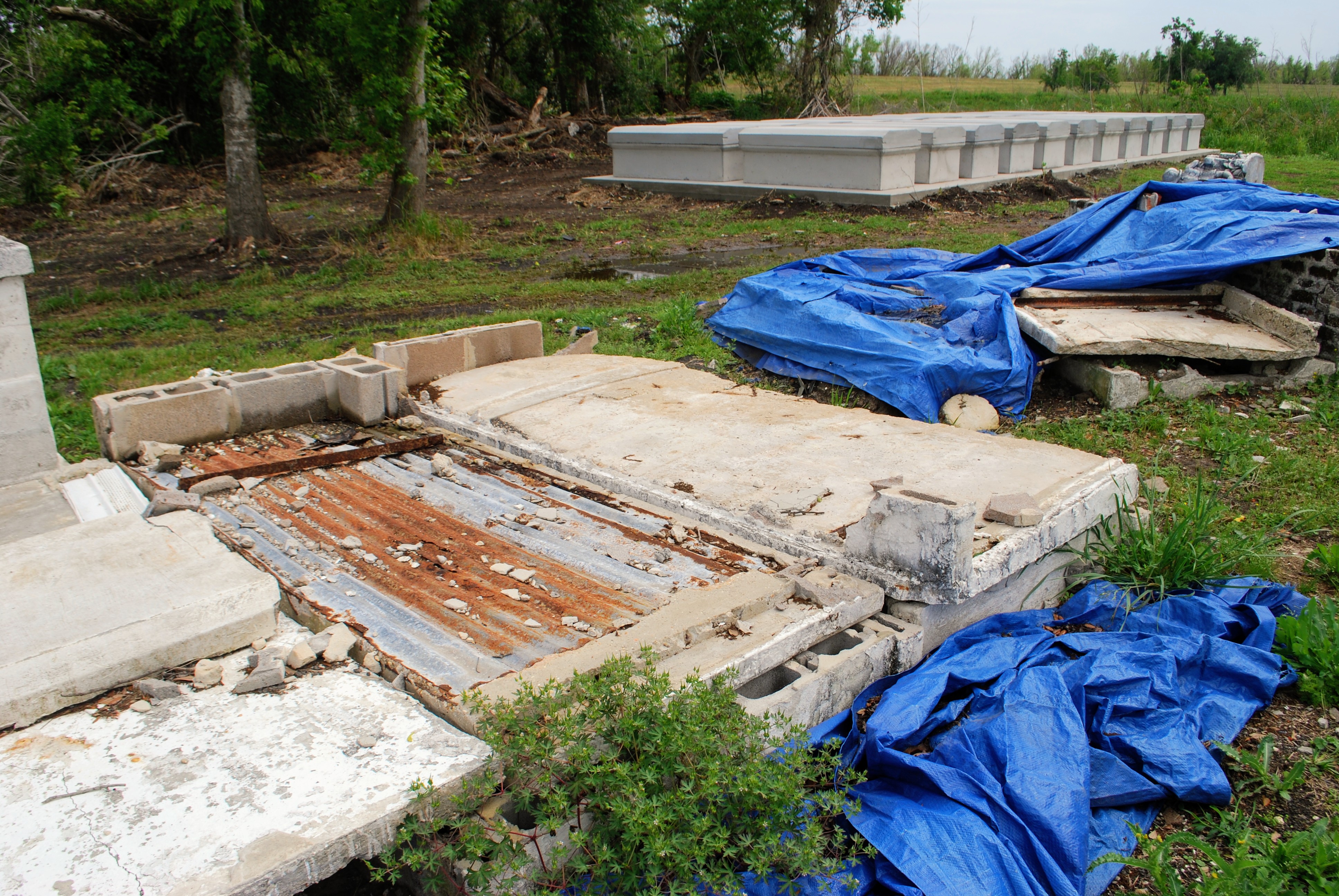
Slow recovery work
Seidmann of the Cemetery Response Task Force said that the trailers were placed beside Ironton Road because the lot is public property, so the state doesn’t have to pay anybody for storage. “The trucks of remains were placed near the community with consultation and agreement from the community so that the families would know where they were and that they were safe,” he said.
He says it’s also because the community expressed that they weren’t comfortable with their loved ones’ remains being taken away from Ironton. “Several individuals since then have said it’s upsetting, and I get that,” Seidmann acknowledged of the trailers’ placement, “but it was partly at their request”.
He added: “We have never received an actual request to move them. We are always willing to accommodate the community in this regard if that is what they want.”
Hargroder of the Justice Department said the trailers are parked where they are because it makes it “easier for members of this community to collaborate with the Task Force” if the trailers are near the town. She added that through “collaborative efforts with the Ironton community, roughly 50% of the deceased in question have been returned to their proper resting places”.
“I don’t know what to tell you,” Seidmann responded when asked by phone about the delay in Ironton’s cemetery recovery. “We had caskets in marshes, in trees, underwater, in multiple parishes, with hundreds of them displaced.”
He says residents should expect it to be years before the cemetery is fully repaired, and adds that Ironton is in fact “further along” in its recovery than other areas hard-hit by Ida. Jean Lafitte did have hundreds of caskets stacked by the side of the road next to an abandoned church, but those were removed to publicly owned land elsewhere by March 2023.
Today, three trailers have been removed, the bodies inside them identified and once again laid to rest in the Ironton Cemetery. The other three trailers are still sitting on the side of Ironton Road, still holding remains in body bags, most of whom have been identified but are still waiting for contractors to finish building additional concrete pads to hold the vaults, and for FEMA reburial funds.
The bodies that haven’t been identified will remain in the trailers, probably for months, Seidmann says, as they now begin a new stage of arduous identification work, which involves detailed interviews with families.
Seidmann says there are a few reasons cemetery repair takes so long: One is that a great deal of the initial response is “consumed by negotiating the very complex ins and outs of FEMA”. Only FEMA-approved contractors may be reimbursed for recovery and cemetery repair work, and the process of approval and funds disbursement is “long, slow, bureaucratic”, he explains. Furthermore, the process of securing reburial funds, which are distributed directly to the families who then pay the reinterment cost is “the exact opposite of easy and intuitive”, said Hargroder.
Other times things “have fallen through the cracks” at FEMA, Seidmann says: Families have called for updates only to learn their files have been left to sit, or ignored or lost completely. These hurdles contribute to FEMA’s history of racial and social inequities in aid distribution, as well as accusations of broad mismanagement and excessive red tape, part of a recovery system so rife with problems that it’s sometimes referred to as “the disaster after the disaster”.
In a response over email to questions from Al Jazeera about inequities in aid distribution and bureaucratic hurdles, a FEMA spokesperson noted that in 2021, the agency announced changes to its policies with the intention of reducing “barriers experienced by underserved populations”. The FEMA spokesperson said they’ve paid assistance to 170 eligible families for reinterment needs after Hurricane Ida.
The spokesperson did not respond to a question regarding Seidmann’s allegations that reburial delays are primarily due to FEMA bureaucratic hold-ups and issues like missing files.
Seidmann says there are also very few contractors qualified and willing to do the work. The recovery work is also slow, he says, because the Task Force is unwilling to “rush” the process of identifying disinterred remains.
“We got to get it right the first time,” Seidmann says. “Once we reinter someone, we can’t go back.”
Since FEMA doesn’t pay for more expensive DNA testing, the Task Force relies on “traditional forensic and anthropological methods”, says Seidmann. Task force analysts, with the help of Louisiana State University graduate students, look for anything in the casket that might help, such as objects or photos people were buried with. They’ll ask the family to fill out a form, recording identifying details they remember about the body of the deceased: Surgical scars, clothing, childhood broken limbs, the kind of clues that help them even when only bones are left behind.
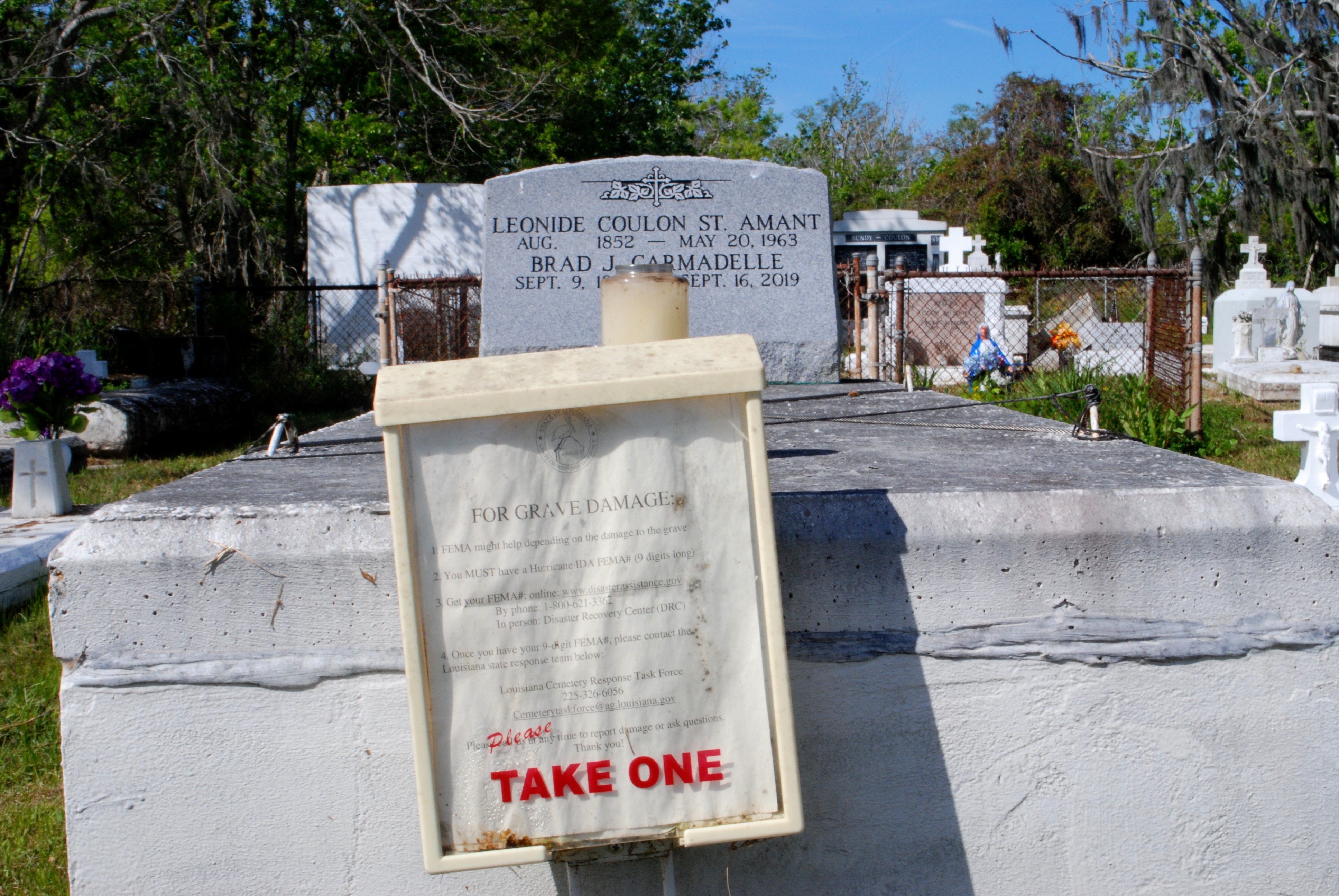
‘Folks are this close to losing it’
As Ironton’s unburied wait in unrefrigerated semitrailers in a sun-blasted field, this constant reminder of the dead has been extremely damaging to the community’s mental health, says Salvant.
“The callousness of it,” she says of the situation. “Would they be doing that if that was their loved ones?” She hesitates, then names it: “There’s no word for it other than racism.”
She leans forward then and shares something she’s heard a lot during monthly meetings with the community since Ida: “We are walking zombies” from the trauma of the storm and protracted recovery efforts, she recounts quietly. “Just … walking.”
Salvant says they’re hoping to bring in mental health professionals from historically Black colleges and universities. “Folks are this close to losing it. I’ve seen a change in a lot of my neighbours,” she says, her voice growing strained. “They’re not going to ever recover from this.”
She says she has asked Seidmann to empty the trailers and move them away as quickly as possible but got only vague reassurances. If she were younger, she adds, she would’ve given him hell.
“There was (and is) absolutely no mal-intent intended with the placement of the trucks,” said Seidmann over email, adding that he’s “deeply saddened and sorry” for any hurt caused.
Asked about the allegation that the handling of the trailers reflects racism, he said: “I am very disheartened to hear that our efforts to assist the community have apparently resulted in this perception. I invite the community members to reach out to me about this and we will accommodate the community’s wishes.”
As in Cameron, not all the missing caskets have been found.
Despite the community’s vulnerability and the strengthening storms, Salvant is intent on remaining in Ironton, though the land in Plaquemines Parish, like the rest of coastal Louisiana, is rapidly disappearing. According to Louisiana’s Coastal Protection and Restoration Authority (CPRA), within 45 years, more than half of Plaquemines will likely be underwater.

Tending graves
Mary Gregoire says she’s got a lucky charm in Prevost Cemetery.
Chatty and open, with huge clear eyes, Gregoire, 76, lives with her husband and son in Ashland, Terrebonne Parish, located between Plaquemines and Cameron. Their home is a brown trailer with white shutters, steps from a narrow bayou that still bears small islands of hurricane debris and broken boats. Decades back, when she was young, she worked at the shrimp factory that once existed nearby. Now, in the small carpeted living room, Gregoire, in a grey bob and a Las Vegas T-shirt, takes a seat on a brown plastic-upholstered chair and begins to explain her bargain with the dead.
“My husband said I was crazy talking to dead people,” she says slyly, peeking playfully over to where he sits on the living room couch, facing a blank flatscreen TV.
Her great-grandfather and infant brother are buried a couple of miles away, in Prevost Cemetery, on the side of a road called Shrimper’s Row. She visits them every All Soul’s Day, November 2, the traditional day to care for cemeteries in Catholicism, bringing flowers, a bag for trash, and a shovel for killing snakes. She whitewashes the headstones if they need it, too.
While she’s there, “I tell ‘em, ‘Now, look. Y’all buried here. I’m cleaning y’all up. Now I want y’all to help me. Y’all know I like to gamble … Y’all help me into winning enough money to where I could get you out of here, put y’all in a better place.’”
Sometimes, she swears, it works. Once, on the slots, she hit $8,000.
But she knows the cemetery is sinking, threatened by floods more every year. If she ever got enough money together, she would move them inland to the city of Houma.
For now, she beats back through the grass to the little white cross where her infant brother is buried. Maybe, she muses, looking down at the ground dotted by snake holes, since he was a small, stillborn baby, moving him wouldn’t be too expensive.
Gregoire is not alone in thinking about moving her buried loved ones. But Schexnayder, the anthropologist, notes that moving cemeteries inland or protecting them permanently from sea level rise simply isn’t practical.
In addition to expenses, which typically run in the thousands of dollars, moving a buried person requires multiple permits and the consent of the deceased’s living family members, which can prove very difficult to get. Moving an entire cemetery, then, is virtually impossible.
“We have to acknowledge that we’re not going to be able to physically save them,” says Schexnayder.
Instead, she believes communities will have to find ways to accept the loss – and soon. Within 25 years, CPRA predicts Shrimper’s Row will experience high tide flooding as often as every week, up from the current 14 weeks each year.

Encroaching wetlands
Jonathan Foret, 45, born and raised in the small nearby bayou community of Chauvin, knows this well. As director of Houma’s wetland discovery centre, he’s painfully aware that the bayou’s cemeteries – and his hometown – are gradually slipping under the water.
Foret, dark-haired and gregarious, lights up when he talks about the bayou, about cooking the hearty Louisiana meal known as alligator piquante, or about the “rougarou,” a kind of swamp werewolf from Cajun folklore. He’s sitting in his office in Houma, a few miles inland from Prevost.
“It’s very personal to me,” he says, “because my great-grandfather is located in a cemetery … that is washing away.”
His great-grandfather, Elwood Henry, a sugarcane harvester, is in Elpege Picou Cemetery. Built on a 1,000-year-old Native American mound, the edge of the cemetery slopes down into brush. A few feet past that begins the open waters of the marsh, within which sit tangled snarls of metal siding, blown there by powerful winds. Once, all this was solid ground.
“The wetlands are encroaching all around this little mound,” explains Foret. “You’ve got to watch out for alligators and stuff when you go visit your loved ones.”
Like Ironton and Cameron, these communities in Terrebonne Parish have never fully recovered from recent record-breaking hurricanes. The road runs past houses still missing half their roofs, or fringed by the shredded blue tarps used to cover holes.
Foret loves the bayou. But he is under no illusion that the cemetery can be saved. Even if it were moved, he points out, the new site could also become vulnerable. “In 50 years, how far north are you going to have to move these bodies? … These folks are just going to have a sort of burial at sea,” he says, and, disturbed by the idea, proceeds to describe a future when boats trawl for shrimp in the water above his ancestor’s submerged grave.
But Foret is searching for ways to accept that reality. “These sites are going to be lost,” he says firmly. “And that’s going to start happening across the world.”
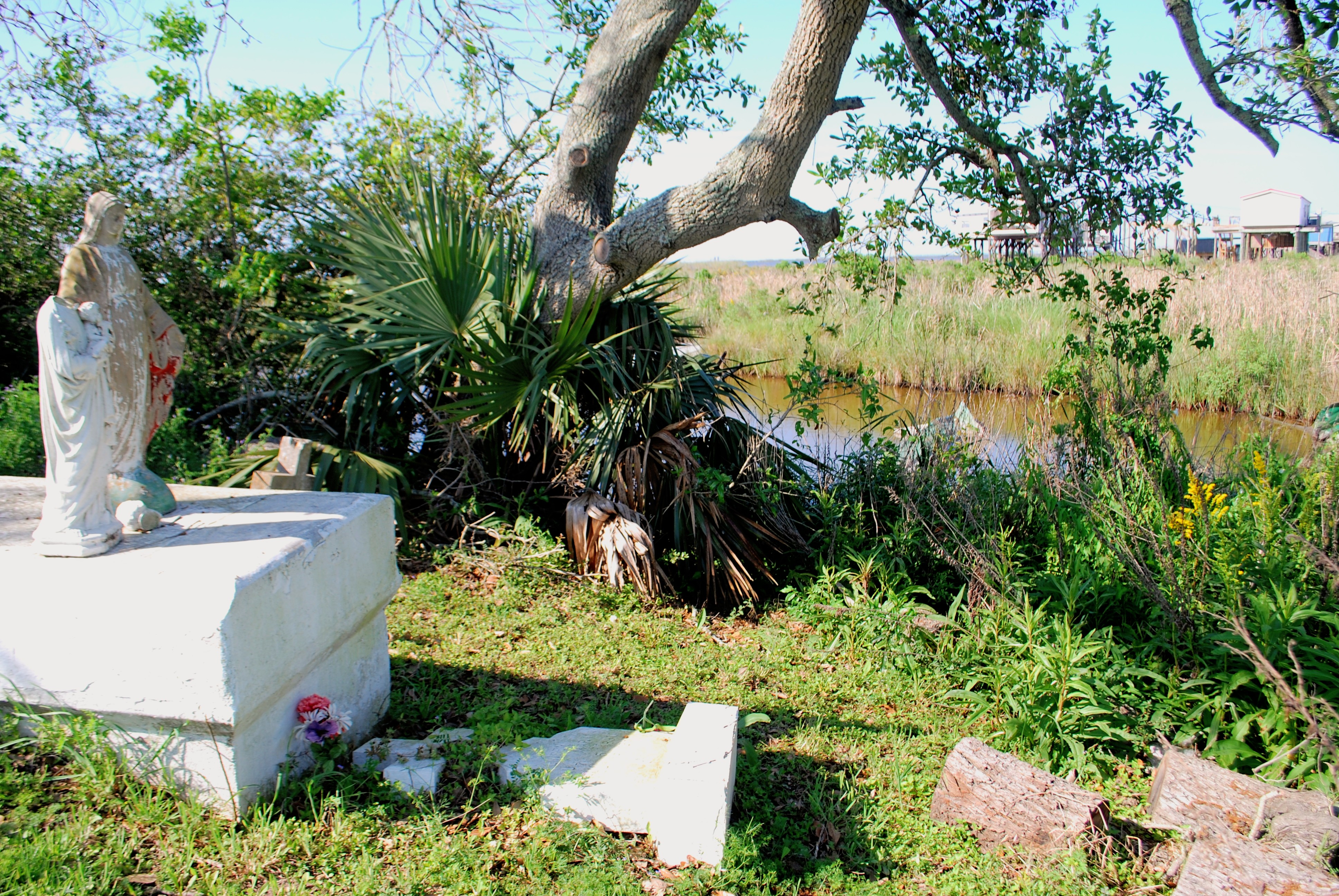
‘People are tied to these burial grounds’
Foret also works with the Bayou Cultural Collective, which looks at migration and cultural preservation in the face of Louisiana’s land loss. Catching shrimp in a cast net, making roux for a gumbo and speaking Louisiana French – what will these bayou traditions look like, Foret wonders, as populations are forced inland?
These practices should be preserved, he says, but they also “have to respond to the holder of the culture” – so, he says, his grandchildren might not make a roux the same way he does, but he hopes they’re able to make it taste pretty close. Likewise, as cemeteries are lost, he suggests communities will need to create new rites and rituals around mourning.
That may mean moving towards different ways of handling remains, like cremation as opposed to burial. It also means finding a way to make peace with inevitably losing some cemeteries to the sea.
“There needs to be a way to help community members come to terms with letting those historical cultural sites go,” he says.
Schexnayder agrees.
“People are tied to these burial grounds,” Schexnayder explains. “And when they are forced inland, due to climate, hurricanes, climate change, land erosion – it changes the narrative. It changes who they are.”
As Foret points out, communities elsewhere are soon going to be facing the same dilemma soon. Rising seas have been washing away graveyards from the Marshall Islands to Guatemala to Nova Scotia.
When people can’t access traditional sites of mourning, Foret suggests that immigrant and refugee communities can serve as a model for how to honour ancestors. “Maybe that’s how we start new traditions,” he muses. A cemetery anchors a community to a place, he says, “but if we have to go, then we have to cut that [anchor] chain … in order to survive.” His own traditions, he muses, came from refugees: The Cajuns are descendants of the Acadians, who were exiled from Canada and fled to Louisiana in the 18th century.
But giving up graveyards will be a difficult sell. Much of southern Louisiana is culturally Catholic, which forbids cremation. And religion aside, people are protective of their mourning rituals. After the 2016 floods in central Louisiana, Livingston Parish implemented an ordinance mandating underground burials, which are far less vulnerable to disinterment by storm surge.
The mandate was met with such vitriol by the public that the parish council amended it within a couple of months to again allow above-ground vaults.
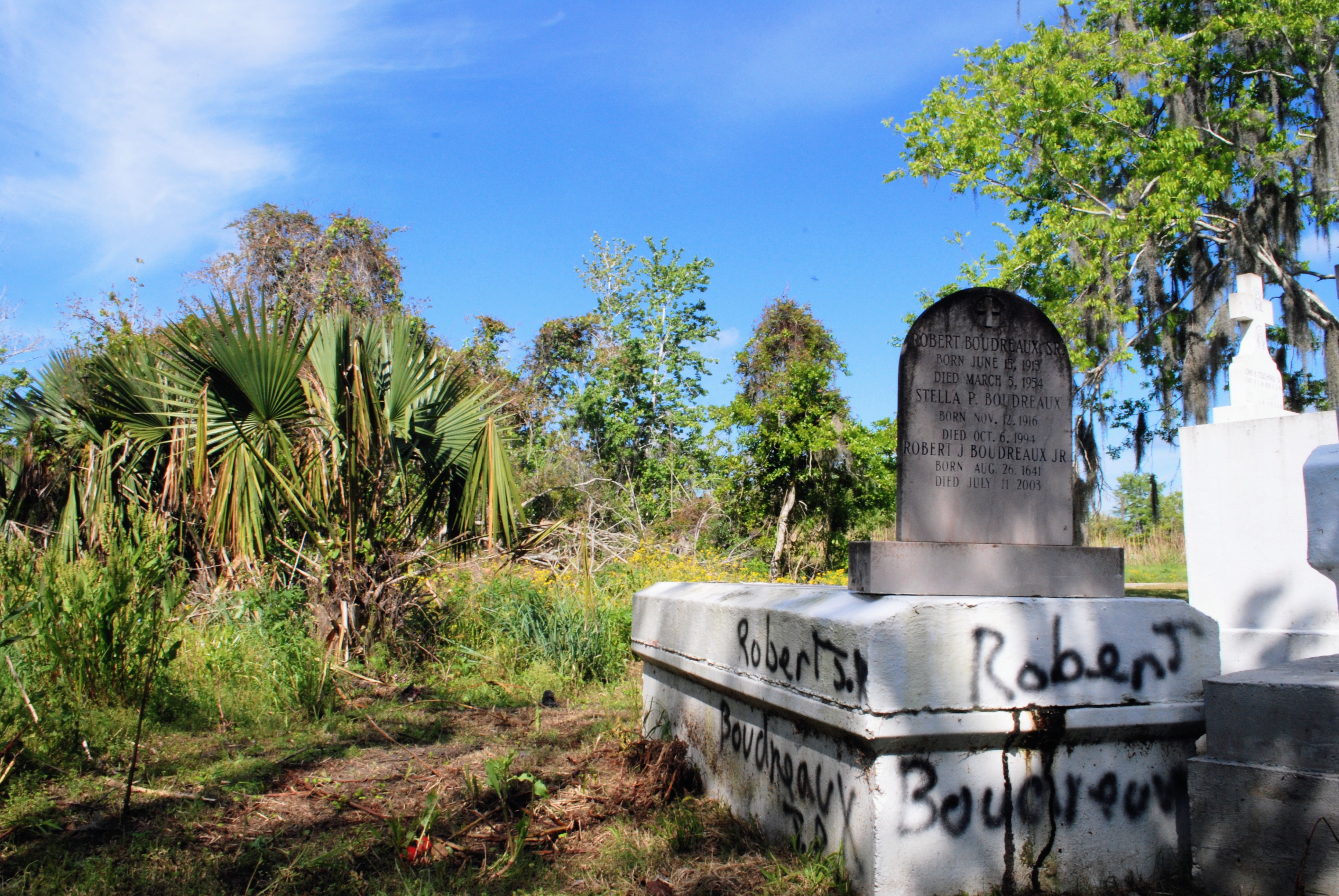
‘You can’t come back’
It is tough for Foret to stomach the fact that his two-year-old son may be the last generation to live down the bayou. But in the last decade, he says he’s witnessed land loss accelerate. “We watch it happen every day,” he says.
Indeed, sea levels started rising much, much faster in the Gulf about a decade ago.
“We are honestly watching the collapse of a community. Look,” he says. “I knew this was coming. I just didn’t think I would see it in my lifetime.”
He’s looking now for ways to cope. To help communities displaced by the climate crisis, Foret envisions a kind of workbook that could provide guidance and help people come to terms with losing these spaces.
One section would be on the loss of cemeteries. Others would look at lost skylines, schools, grocery stores and churches. “Those things that held them together as a community,” he explains.
His words echo those of Hebert, who, mourning his hometown of Cameron, had noted: “If you don’t have a church, and a store, and a school – man, it’s just – you can’t come back.”
Others are determined to stay, even as the waters rise.
“We’re not going anywhere,” says Salvant. Ironton, and its cemeteries, are too precious to leave behind. “This is home for us.”
Foret doesn’t want to go, either.
“I love Louisiana,” he says. But he’s thinking about what’s best for his son.
Sea levels here, as measured by tide gauges in New Orleans, have already risen 20cm (8 inches) since 2006. Last year, a study calculated that under an intermediate-high sea level rise scenario, Louisiana will see 2.6 metres (8.5 feet) of sea level rise by 2100.
And so in June, Foret drove up to Michigan with his mother and son to look at land and “see what felt the most like home”. He was comforted to see the abundance of lakes, cattails, and water lilies. He’s not quite ready to leave yet. But he hopes that someday, when he and his neighbours are forced to give up the bayou, he can invite them to join him there. But “it was difficult”, he admits.
“I really don’t want to leave,” he says. “I really, really don’t. But it doesn’t matter what I want.”







